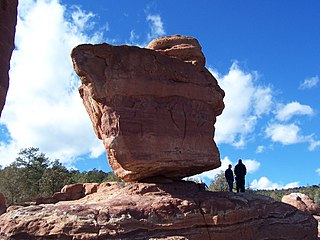
In geology, a boulder is a rock fragment with size greater than 25.6 centimetres (10.1 in) in diameter. Smaller pieces are called cobbles and pebbles. While a boulder may be small enough to move or roll manually, others are extremely massive. In common usage, a boulder is too large for a person to move. Smaller boulders are usually just called rocks or stones. The word boulder derives from boulder stone, from the Middle English bulderston or Swedish bullersten.
Scouting in New Jersey has a long history, from the 1910s to the present day, serving thousands of youth in programs that suit the environment in which they live. The second Boy Scouts of America National Headquarters was in North Brunswick, although it was referred to in BSA publications as being in neighboring New Brunswick.

Glen Rock is a borough in Bergen County, in the U.S. state of New Jersey. As of the 2020 United States census, the borough's population was 12,133, an increase of 532 (+4.6%) from the 2010 census count of 11,601, which in turn reflected increased by 55 (+0.5%) from the 11,546 counted in the 2000 census.

A glacial erratic is glacially deposited rock differing from the type of rock native to the area in which it rests. Erratics, which take their name from the Latin word errare, are carried by glacial ice, often over distances of hundreds of kilometres. Erratics can range in size from pebbles to large boulders such as Big Rock in Alberta.

The Main Line is a commuter rail line owned and operated by New Jersey Transit running from Suffern, New York to Hoboken, New Jersey, in the United States. It runs daily commuter service and was once the north–south main line of the Erie Railroad. It is colored yellow on NJ Transit system maps, and its symbol is a water wheel.

The Bergen County Line is a commuter rail line and service owned and operated by New Jersey Transit in the U.S. state of New Jersey. The line loops off the Main Line between the Meadowlands and Glen Rock, with trains continuing in either direction along the Main Line. It is colored on NJT system maps in grey, and its symbol is a cattail, which are commonly found in the Meadowlands where the line runs.

Ridgewood is a neighborhood in the New York City borough of Queens. It borders the Queens neighborhoods of Maspeth to the north, Middle Village to the east, and Glendale to the southeast, as well as the Brooklyn neighborhoods of Bushwick to the southwest and East Williamsburg to the west. Historically, the neighborhood straddled the Queens-Brooklyn boundary.

Ridgewood High School is a four-year comprehensive public high school in Ridgewood, in Bergen County, in the U.S. state of New Jersey, serving students in ninth through twelfth grades as the lone secondary school of the Ridgewood Public Schools.

Glen Rock High School is a four-year comprehensive public high school serving students in ninth through twelfth grades from Glen Rock, in Bergen County, in the U.S. state of New Jersey, operating as the lone secondary school of the Glen Rock Public Schools. The school shares a campus with Glen Rock Middle School.

Wood-Ridge is an active commuter railroad train station in the borough of Wood-Ridge, Bergen County, New Jersey. Located next to the interchange of Route 17 and Moonachie, the single low-level side platform station services trains of New Jersey Transit's Pascack Valley Line between Hoboken Terminal and Spring Valley. The next station to the north is Teterboro and to the south is Secaucus Junction. Wood-Ridge station is not accessible to handicapped persons and contains parking along Park Place East.
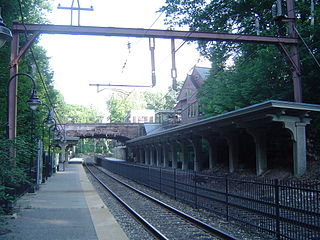
Glen Ridge is a New Jersey Transit station at the intersection of Bloomfield Avenue and Ridgewood Avenue in Glen Ridge, Essex County, New Jersey along the Montclair-Boonton Line. Service through Glen Ridge comes from Hoboken Terminal and New York Penn Station and goes through to one of four termini, Bay Street, Montclair State University, Dover and Hackettstown. The station depot is on-grade level with Ridgewood Avenue, with the platform and tracks below street-level.

Tripod Rock is a glacial erratic, in this specific case a balancing rock, or perched boulder, located in Kinnelon, New Jersey in the Pyramid Mountain Natural Historic Area. This multi-ton Precambrian gneiss boulder, located near the edge of a long ridge, is balanced on three smaller boulders. Tripod Rock is roughly 6 m (20 ft) long, 3 m (9.8 ft) wide, and 2.5 m high, weighing approximately 127 tonnes (280,000 lb). A triangular crest runs the length of its top. The boulder is balanced on three smaller stones roughly 1 m in diameter that raise it above the bedrock by about 0.5 m at its lowest point. The point of contact between the boulder and its support stones forms an approximate 3-4-5 triangle.
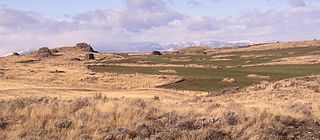
The Withrow Moraine and Jameson Lake Drumlin Field is a National Park Service–designated privately owned National Natural Landmark located in Douglas County, Washington state, United States. Withrow Moraine is the only Ice Age terminal moraine on the Waterville Plateau section of the Columbia Plateau. The drumlin field includes excellent examples of glacially-formed elongated hills.

Glen Rock is one of two railroad stations operated by New Jersey Transit in the borough of Glen Rock, Bergen County, New Jersey, United States. Located on the Main Line, the station is signed as Glen Rock–Main Line to differentiate it from the Glen Rock–Boro Hall station, which lies two blocks east on Rock Road on the Bergen County Line.

Ridgewood is a railroad station operated by New Jersey Transit in the village of Ridgewood, Bergen County, New Jersey, United States. A major transfer station, Ridgewood has two high-level platforms for the Main Line and Bergen County Line.
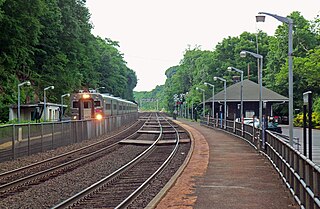
Ho-Ho-Kus is a NJ Transit station served by the Bergen County Line and Main Line. The station is located in Ho-Ho-Kus, New Jersey, at Brookside Avenue and 1st Street, across the bridge on Warren Avenue from Franklin Turnpike.

Glen Rock–Boro Hall is one of two railroad stations operated by New Jersey Transit in the borough of Glen Rock, Bergen County, New Jersey, United States on the Bergen County Line. Its name comes from the fact that the Glen Rock Municipal Building is located immediately east of the station, and to differentiate it from the Glen Rock–Main Line station, which lies two blocks west on Rock Road.

The Vander Ende–Onderdonk House, also known as the Van Nanda House, is a historic house at 1820 Flushing Avenue in Ridgewood, Queens, New York City. It is the oldest Dutch Colonial stone house in New York City.
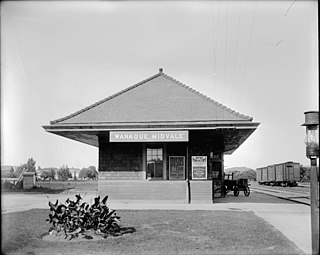
Wanaque–Midvale was a former commuter railroad station of the Erie Railroad's New York and Greenwood Lake Railway branch in Wanaque, New Jersey, United States. When built in 1873, the station served trains running from Pavonia Terminal in Jersey City to Sterling Forest on the New York–New Jersey border alongside Greenwood Lake and trains going to Ringwood on the Ringwood Branch. At the time there were two stations, one at Wanaque and one at Midvale. The next station northbound towards Sterling Forest was Boardville; heading towards Ringwood it was Erskine. The next station south was Haskell.
Frances McGrath was an American actress.






















